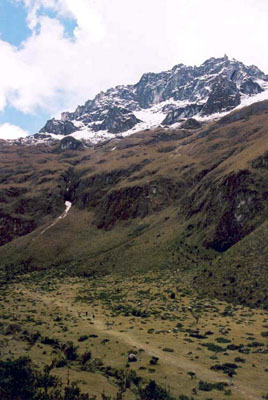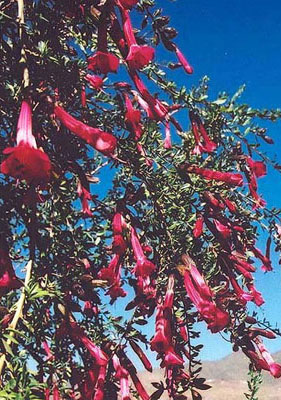

 |
 |
Miscellany
Trekking in the Peruvian Andes
by Jackie Yip
I visited the Peruvian Andes in August to trek the Inca Trail – a 50 km trail which ends up in the historical ruin of Machu Picchu in southern Peru. The trek was not exceedingly strenuous, leaving me abundant time for appreciating the beautiful scenery and the diverse flora along the route. The trail ranged in altitudes between 2600 m and 4200 m. This variation of altitudes results in a change of habitats over the four-day hike. At this altitude, the flora and fauna do not resemble anything that I am familiar with in Hong Kong, so I am only able to give a brief account of the habitats.
The trail starts at 2600 m, among the sparsely vegetated Cactus and Agave habitats. After 3000 m, the trail climbs steeply through the humid Polylepis woodlands, with rich diversity of mosses, ferns and lichens. This is one of the few shaded sections of the trail. Steady ascent up the first pass took us through the puna – high-elevation grassland characterized by tussock grass and pockets of alpine flowers. On the third day, the hike descended through the upper fringes of the cloud forest – a zone of nocturnal fogs, made temperate by increasing proximity to warm air rising from the Amazonian lowlands. Here we had the highest variety of plants and birds. Amazingly, a section of the trail was lined by bamboos, and another section by a species of tree fern. The Machu Picchu Historical Sanctuary holds a stunning diversity of orchids, with some 250 species identified. Spectacular orchids can be seen along this section of the trail, together with numerous wild flowers, including the national flower of Peru Cantua buxifolia (Polemoniaceae), a bright red flower frequented by hummingbirds. Over 370 species of birds have been identified in the Sanctuary. To my untrained eyes, and without the aid of binoculars, birds were heard but seldom located.
The Indians living in the Andes are Quechuas, who are direct descendents of the Inca Empire. My guides, being Quechuas, also knew some of the plants and their traditional uses by the Incas. The plants on the Andes form an important part of the daily life and culture of the Incas, being used as medicine, food, material for utensils, and soil stabilisers. A book recommended for understanding the ecosystems is Machu Picchu Historical Sanctuary (1995), edited by Peter Frost and Jim Bartle. The bird watching guide is Birds of the High Andes (1990) by Nils Krabbe and Jon Fjeldsa. However, I was unable to locate either book in Lima.
 |
 |
|
Puna grassland against a background of snow-capped peaks. |
Cantua buxifolia, the national flower of Peru. |
|
|
P.22 |
|
Porcupine! |
 Copyright © 2000 |